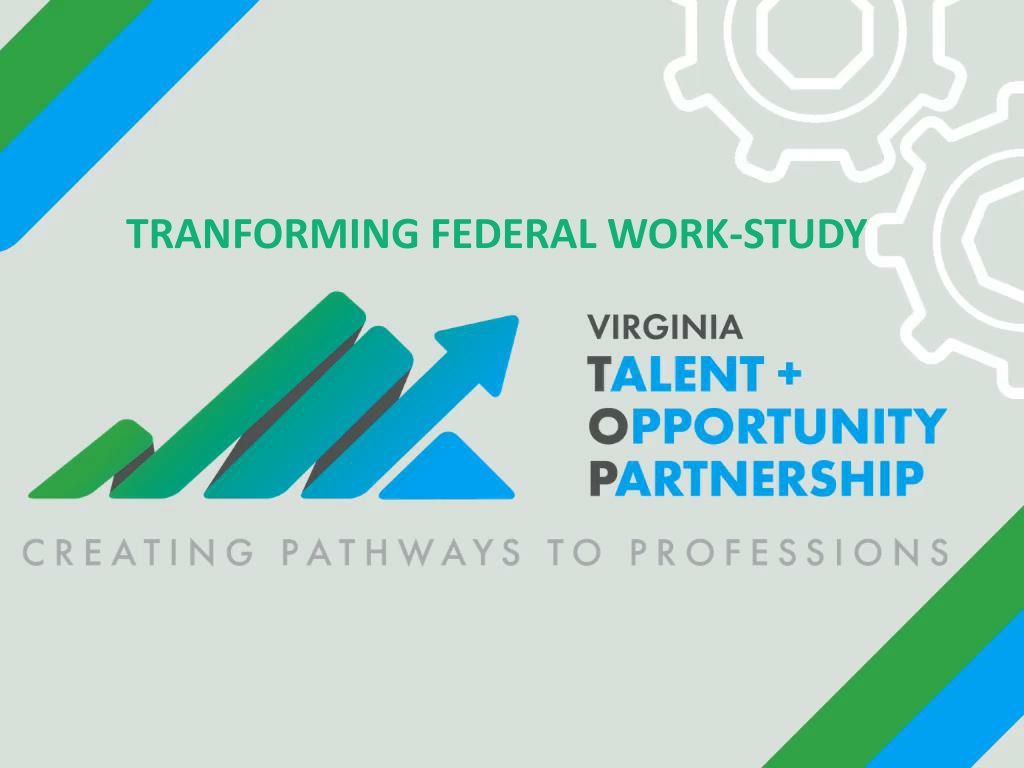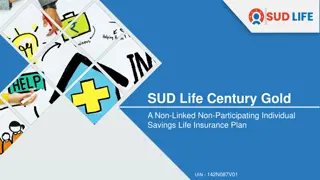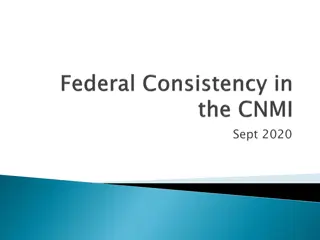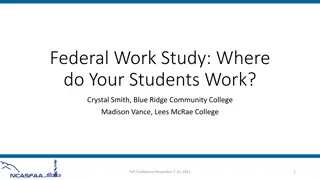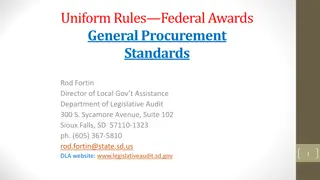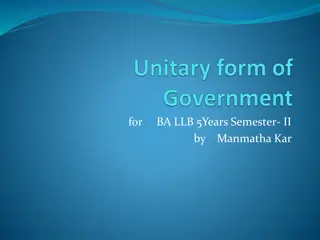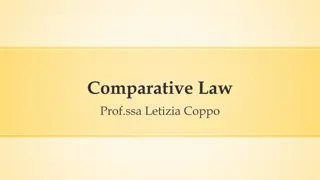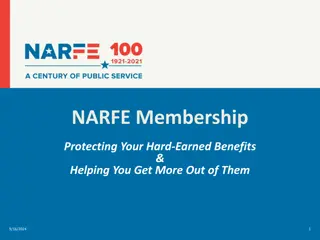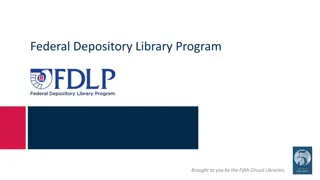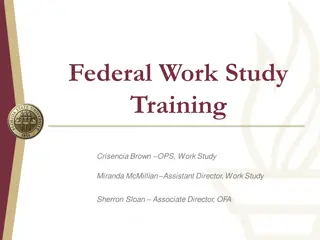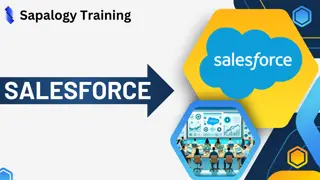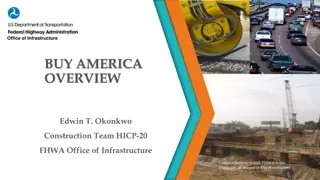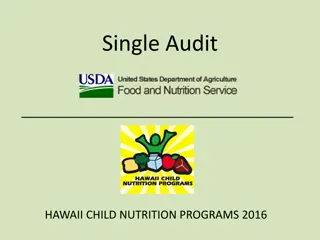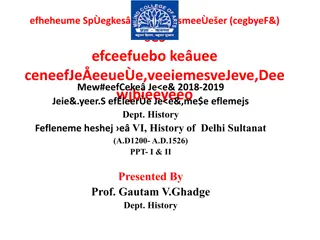TRANFORMING FEDERAL WORK-STUDY
Enhance student opportunities with the Virginia Transforming Federal Work-Study program. This initiative aims to expand paid internships and work-based learning opportunities in collaboration with Virginia employers. By prioritizing student readiness and fostering partnerships between institutions of higher education and industry, Virginia aims to become a top state for business, education, and talent. Discover the benefits of work-based learning, including increased wages post-graduation and improved career satisfaction. Addressing disparities, the program seeks to provide equal access to paid internships for all students, regardless of background.
Download Presentation

Please find below an Image/Link to download the presentation.
The content on the website is provided AS IS for your information and personal use only. It may not be sold, licensed, or shared on other websites without obtaining consent from the author.If you encounter any issues during the download, it is possible that the publisher has removed the file from their server.
You are allowed to download the files provided on this website for personal or commercial use, subject to the condition that they are used lawfully. All files are the property of their respective owners.
The content on the website is provided AS IS for your information and personal use only. It may not be sold, licensed, or shared on other websites without obtaining consent from the author.
E N D
Presentation Transcript
TRANFORMING FEDERAL WORK-STUDY VirginiaTOPorg www.VirginiaTOP.org
BACKGROUND BACKGROUND VirginiaTOPorg www.VirginiaTOP.org
V V- -TOP Statutory Purpose TOP Statutory Purpose Grants to institutions to expand paid and credit-bearing student internships and other work-based learning opportunities in collaboration with Virginia employers. Statewide Initiative to facilitate the readiness of students, employers and institutions of higher education to participate in internship and work-based learning. MAKING VIRGINIA THE TOP STATE FOR BUSINESS, EDUCATION AND TALENT VirginiaTOPorg www.VirginiaTOP.org
TOP TOP State for Talent State for Talent Distinguish the Commonwealth of Virginia as the leading state for higher education and talent pathways Most internship-ready students, employers and institutions of higher education 100,000 new internship slots by 2033 Every student enrolled at a Virginia institution of higher education has the opportunity to graduate with a paid, employment-based, authentic, applied learning experience (goal drafted by Council of Presidents work group) VirginiaTOPorg www.VirginiaTOP.org
Work Work- -Based Learning: Based Learning: Benefits to Students Benefits to Students $3,096: Increase in annual wages one year after graduation for students who took a paid internship, even when accounting for differences in pay based on field of study, gender, and race/ethnicity Other work-based learning experiences unpaid internships, practicums, and cooperative learning are not associated with an earnings benefit one year after graduation Among current students, paid internships are linked with greater confidence they will be successful in the job market and confidence in the value of their education VirginiaTOPorg www.VirginiaTOP.org
Work Work- -Based Learning: Based Learning: Benefits to Students (cont d) Benefits to Students (cont d) Work-based learning defined more generally is tied to noneconomic post-graduation success Bachelor s degree holders who had a work-based learning experience report greater career satisfaction and are more likely to say their education helped them to achieve their goals and was worth the cost Access to paid internships is uneven Black and Latino students, women, low-income, and first-generation students are less likely to experience a paid internship. Even when controlling for variation across majors, these disparities remain Source: Strada, The Power of Work-Based Learning, March 2022 VirginiaTOPorg www.VirginiaTOP.org
WHY TRANSFORM FEDERAL WHY TRANSFORM FEDERAL WORK WORK- -STUDY? STUDY? VirginiaTOPorg www.VirginiaTOP.org
BENEFITS of TRANSFORMING FWS BENEFITS of TRANSFORMING FWS Expands internships/work-based learning to more students and achieving the ambitious goal of 100,000 internship slots by 2033 by making at least some on-campus jobs more internship-like. Improves equitable access to internship-like opportunities by transforming at least some FWS/on-campus jobs to be more internship-like. Enhances the learning outcomes/experience associated with on- campus jobs, enabling students to make better connections with coursework. VirginiaTOPorg www.VirginiaTOP.org
HOW TO TRANSFORM FEDERAL WORK HOW TO TRANSFORM FEDERAL WORK- - STUDY? STUDY? VirginiaTOPorg www.VirginiaTOP.org
Stages of Transformation Stages of Transformation The diversity Virginia s Institutions of Higher Education (IHE) is both a strength and a challenge: there is no one- size fits all approach and different IHEs are at different stages of the transformation: 1. Implementation Planning 2. Piloting the Transformation 3. Scaling the Transformation VirginiaTOPorg www.VirginiaTOP.org
FWS Toolkit FWS Toolkit In 2022, SCHEV convened a workgroup of IHE financial aid, FWS and career services professionals to inform the development of a toolkit for IHEs to use regardless of where they were at in the process. The toolkit offers guidance, considerations, questions to ask, and resources/case studies designed to be useful wherever an institution is at in the process and regardless of organizational structure offices and staff involved in FWS implementation and so that IHEs don t need to start from scratch. The toolkit allows the IHE user to select their own path and offers guidance/steps along the transformation journey. VirginiaTOPorg www.VirginiaTOP.org
IMPLEMENTATION PLANNING IMPLEMENTATION PLANNING VirginiaTOPorg www.VirginiaTOP.org
Implementation Planning Implementation Planning Implementation Planning: This portion of the toolkit applies to institutions just starting to think about (or in the midst of) aligning key offices, functions, positions and shoring up leadership support for the transformation. This stage is predominately institution/internally-focused. VirginiaTOPorg www.VirginiaTOP.org
Implementation Planning Implementation Planning - - Framework Framework Internal Coordination/Organization Structure Offices/Units/Departments to Involve and Roles Key Questions to Ask Potential Barriers, Resource Needs and other Considerations VirginiaTOPorg www.VirginiaTOP.org
Implementation Planning Implementation Planning - - Framework Framework Internal Coordination/Organization Structure - Offices/Units/Departments to Involve and Roles: FWS Office Career Services Financial Aid Experiential Learning Teams Alumni Affairs Executive leadership HR IT Office of Institutional Effectiveness VirginiaTOPorg www.VirginiaTOP.org
Implementation Planning Implementation Planning - - Framework Framework Internal Coordination/Organization Structure - Key Questions to Ask: Is there a natural fit for an entity/position to lead this effort or co-lead this effort? What is their currently involvement with FWS? With internships? Do they have the experience, understanding, time and resources to facilitate the transformation? What additional resources do they need to convene key partners in order to facilitate implementation and pilot the transformation? What other individuals/entities will be involved? How will their responsibilities be delineated? Does there need to be (at least) a rudimentary organizational structure to effectively implement (i.e. develop a transforming FWS org chart which may/not be different than the FWS org chart)? How or will resources need to be re-allocated to undertake the work? What steps are necessary to re-allocate the resources? Who will be responsible for this (or what office?). VirginiaTOPorg www.VirginiaTOP.org
Implementation Planning Implementation Planning - - Framework Framework Internal Coordination/Organization Structure - Potential Barriers, Resource Needs and other Considerations: Maintaining requirements of FWS while transforming on-campus jobs to be more internship-like. Identifying ways to break down silos, streamline efforts and improve communication and collaboration. Recognizing and engaging all of the different positions involved and their roles in FWS and transforming FWS (which may include different roles). Obtaining top-level support to make the transformation a priority. Balancing existing workloads and responsibilities. VirginiaTOPorg www.VirginiaTOP.org
PILOTING THE TRANSFORMATION PILOTING THE TRANSFORMATION VirginiaTOPorg www.VirginiaTOP.org
Piloting the Transformation Piloting the Transformation The second step in the process, once implementation planning is well underway or nearing completion, is to determine how to pilot the transformation and where to start. The approach can vary. VirginiaTOPorg www.VirginiaTOP.org
Piloting Piloting - - Framework Framework Step-by-step process Data-informed Approach Roles and Responsibilities to Consider Transforming the (FWS) Position Evaluating the Transformation VirginiaTOPorg www.VirginiaTOP.org
Piloting Piloting - - Framework Framework Step-by-step process - Data-informed Approach: What on-campus jobs currently fall under FWS? Engage the appropriate entities/positions for data on who qualifies for FWS and how the data can inform the pilot approach. VirginiaTOPorg www.VirginiaTOP.org
Piloting Piloting - - Framework Framework Step-by-step process - Roles and Responsibilities to Consider: Who is responsible and what are their roles/responsibilities? Will there be any associated curriculum/credit for learning or similar requirement? Who will supervise the interns? Staff or faculty? Who will provide guidance on how to write the job description and elevate a FWS position into an internship? How will the job + experiences be scaffolded over time and tied to competencies? How will the transformed FWS position be marketed to students? VirginiaTOPorg www.VirginiaTOP.org
Piloting Piloting - - Framework Framework Step-by-step process - Transforming the (FWS) Position: Building from the job description(s), how will the position(s) be more internship-like? What is the process by which these aspects were determined? Build in workshops. Can existing FWS and internships be combined? Offer mentoring. Connect with a required course. VirginiaTOPorg www.VirginiaTOP.org
Piloting Piloting - - Framework Framework Step-by-step process - Evaluating the Transformation: How will the transformation be evaluated for impact? Refer back to metrics established from implementation planning. What issues arose and how does this impact those metrics and achieving success ? What impacts should inform the continual feedback loop to improve the transformation? How is the institution managing this evaluation process? What entity/position is responsible? How is the institution assessing competency growth in students? VirginiaTOPorg www.VirginiaTOP.org
SCALING THE TRANSFORMATION SCALING THE TRANSFORMATION VirginiaTOPorg www.VirginiaTOP.org
Scaling the Transformation Scaling the Transformation Once the institution has piloted transformed FWS positions, the next phase involves scaling the transformation. The approach can vary. VirginiaTOPorg www.VirginiaTOP.org
Scaling Scaling - - Framework Framework Data-informed Next Steps General Considerations Sustainability Considerations VirginiaTOPorg www.VirginiaTOP.org
Scaling Scaling - - Framework Framework Data-informed Next Steps - General Considerations: How long has the pilot been implemented? What have you learned from evaluating the pilot? Do enough data points exist to inform scaling? What qualitative data have implementation partners provided? How should that be incorporated into scaling the transformation? VirginiaTOPorg www.VirginiaTOP.org
Scaling Scaling - - Framework Framework Data-informed Next Steps Sustainability Considerations: (How) Does the organizational structure need modified to scale? Are there resources available to support the scaling and position(s) growth? Where will funding come from? How much is needed? What other support can be thrown in to resource the scaling? Who will develop and manage the long-term budget and maintenance? How will success be defined? What is the value proposition? Who will promote/market the value proposition internally/externally? How do you build the appeal of the transformed positions? Reputation of the program? Who leads the charge? Using a feedback loop, what are the next logical positions to transform? How can these transformed jobs be made more attractive? What are the ramifications on local employers internships? Compliance if off-campus? VirginiaTOPorg www.VirginiaTOP.org
NEXT STEPS NEXT STEPS VirginiaTOPorg www.VirginiaTOP.org
Competitive RFP to Fund the Competitive RFP to Fund the Transformation Transformation FY 2023/24 V-TOP budget: Transforming FWS grants: $630,000 in 2023/$930,000 in 2024 for institutions to respond via a RFP about how they will use the toolkit to transform FWS at their respective institution. Survey of IHE FWS-associated staff indicates the need for additional staff and internship data-tracking tools/platforms. VirginiaTOPorg www.VirginiaTOP.org
What Can We Achieve Together? What Can We Achieve Together? Talent pipeline progression from high school, to 1st/2nd year, to junior/senior and beyond Students with career-ready skills More employers (including IHEs) offering high-quality work- based learning experiences 21,500 new internship slots by 2026 100,000 new internship slots by 2033 VirginiaTOPorg www.VirginiaTOP.org
Contact Information Contact Information Emily Salmon Senior Associate for Strategic Planning and Policy Studies State Council of Higher Education for Virginia emilysalmon@schev.edu VirginiaTOPorg www.VirginiaTOP.org
